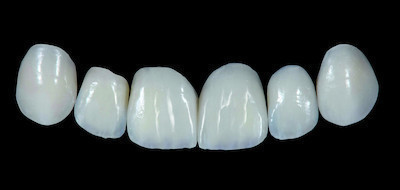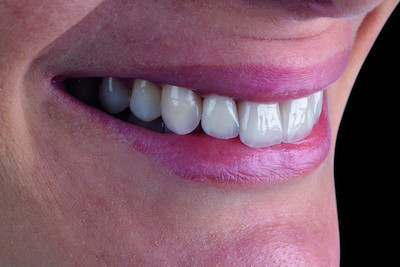Lumex AC article - Highly Individual Reproduction of the Color Play with VITA LUMEX AC Veneering Ceramic if Limited Space Is Available
Highly Individual Reproduction of the Color Play with VITA LUMEX AC Veneering Ceramic if Limited Space Is Available
When veneers are used for cosmetic reconstructions, preserving tooth substance is a high priority. In these cases, patients are often treated using highly individualized, hand-layered veneers. The challenge when it comes to dental technology is in precisely reproducing the natural play of colors and light within a limited space. This requires veneering ceramics with high luminosity, such as the new VITA LUMEX AC, which reliably produces ideal light dynamics, even with minimum wall thicknesses. In addition, the veneering ceramic applied must have good fracture strength in order to ensure safe manual reworking and seating with this delicate type of reconstruction. In the following case study, Master Dental Technician Marcio Breda and Dentist Dr. Estefânia Donato (both Vitória, Espírito Santo, Brazil), show how a patient was supplied with highly esthetic hand-layered veneers made from the leucitereinforced, glass-ceramic veneering ceramic VITA LUMEX AC (VITA Zahnfabrik, Bad Säckingen, Germany).
The patient case
A 35-year-old patient visited the dentist's office, as she was dissatisfied with the esthetics of her anterior maxillary region. The clinical inspection showed very irregular incisal edges. The dental arch and the gingival profile were not harmonious. The length to width ratios were also not adequate. Previous defects were filled with lifeless composite fillings, and teeth 11 and 21 were discolored. The patient wanted a level dental arch, uniform tooth color and an individualized, age-appropriate appearance for her anterior maxillary region. The choice was made to use individually layered veneers made of VITA LUMEX AC veneering ceramic for the restoration.
Planning and preparation
A wax-up was created in order to better discuss the target situation with the patient. After a few minor changes, a silicone key was produced on the wax-up in order to transfer a direct mock-up into the mouth using low viscosity, temporary composite. The patient and dentist were satisfied with the results. Local anesthetic was applied to the anterior maxillary region and tooth shade A1 was selected for the restorations using the VITA classical A1–D4 shade guide. After a full crown preparation was performed for teeth 13 to 23, gingival resection on 11 and 21, and impressions were made of the upper and lower maxillary region, another direct temporary restoration was created intraorally using the silicone key. A master model was made with refractory dies in the laboratory and articulated with the opposing jaw model.
Reliable reproduction of the play of light
The basic tooth shade determined was initially reproduced on refractory dies with VITA LUMEX AC DENTINE A1, followed by a central accentuation using TRANSLUCENT smokywhite. A bluish play of light was integrated by applying TRANSLUCENT waterdrop on the edges. The anatomy of the mamelons could be reproduced using MAMELON saffron. The final shape of the six veneers was then contoured with bluish-translucent ENAMEL light, so that the play of light and color of the enamel could be precisely reconstructed. The ceramic enabled high-precision modeling during the entire layering process, thanks to its extremely high stability, which is due to the excellent microserration of the ceramic particles. Furthermore, the extremely thin veneers showed excellent shape stability after firing. The finalization was ultimately carried out using fine diamond instruments and polishers in order to achieve completely natural results in terms of shape, texture and degree of gloss.
Natural vibrance in the results
During the initial try-in, the patient was already enthusiastic about the results, allowing a rubber dam to be created for the final seating. After appropriate conditioning of the tooth substance, as well as hydrofluoric acid etching and silanization of the veneers, a full-adhesive integration with composite cements could be applied. Despite the limited space, the veneers made of VITA LUMEX AC ceramic showed excellent light dynamics and a very good play of colors with depth effects.

Master Dental Technician Marcio Breda, Vitória, Espírito Santo, Brazil
Fig. 1: INITIAL SITUATION: The immediate temporary restoration was created with a silicone key of the mock-up.

Fig. 2: Production of the master model.

Fig. 3: Refractory dies were produced using the master model.

Fig. 4: The finished master model was ready for fabrication of the veneers.

Fig. 5: The mamelons were further accentuated with MAMELON saffron.

Fig. 6: The final shaping of the six veneers was performed using ENAMEL light.

Fig. 7: The absolutely natural appearance of the six veneers was already visible in the master model.

Fig. 8: Chromacity and translucency were harmoniously balanced.

Fig. 9: The dental arch was shaped according to the rules of esthetics.

Fig. 10: The lips and incisal edges harmonized with each other.

Fig. 11: RESULTS: A highly esthetic smile was created with ease.

